Beyond the Box: Why Your Enclosure Design is a Critical Business Decision
In global product development, it’s easy to view a sheet metal enclosure as a simple commodity—a protective box sourced at the lowest possible cost. This perspective, however, overlooks a critical reality for any wholesale buyer.
A custom sheet metal cover or enclosure is not just a component; it’s an integrated system whose execution directly impacts your product’s performance, reliability, and total cost of ownership. It is your frontline defense against costly field failures and warranty claims.
Common procurement pitfalls we often encounter include:
Underestimating how design tolerances affect unit cost
Overlooking bend radii requirements for different materials
Specifying features that complicate fabrication unnecessarily
Common procurement pitfalls we often encounter include:
Underestimating how design tolerances affect unit cost
Overlooking bend radii requirements for different materials
Specifying features that complicate fabrication unnecessarily
The financial stakes are immense. More importantly, understanding them early in the process helps align design with long-term cost efficiency. Industry analysis shows that early design decisions dictate up to 80% of a product’s lifecycle costs. A seemingly minor oversight, like an incorrect bend radius, can inflate manufacturing costs by 15-25%, causing batch rejections that ripple through your supply chain.
This guide provides the strategic insights to transform your enclosure procurement from a cost center into a competitive advantage.
The Foundation: Mastering Design for Manufacturability (DFM) to Mitigate Risk and Control Costs
Design for Manufacturability (DFM) is the most critical risk mitigation strategy in sheet metal fabrication. It is a disciplined methodology focused on optimizing a design for its manufacturing process, thereby eliminating errors, reducing production time, and controlling unit costs—all essential concerns for wholesale procurement.
On the contrary, a design that ignores DFM principles is destined for delays, budget overruns, and quality control issues.
Avoiding the #1 Trap: A Practical Guide to Bend Radii
In our 26+ years of experience at YISHANG, the most common and costly DFM failure is the improper specification of a bend radius. While CAD software can draw a perfectly sharp corner, the physics of metal deformation make this impossible in the real world.
Forcing a material to bend at a radius that is too tight for its thickness and temper will inevitably lead to stress concentration, cracking, and part failure.
A widely cited rule of thumb is an inside bend radius of at least 1x the material thickness (1T). While safe for soft materials, this is a dangerous oversimplification for others. As a result, material-specific evaluation becomes essential. Harder materials like 304 stainless steel or 6061-T6 aluminum require a much larger radius—often 1.5–2x the thickness or more—to prevent micro-cracking (commonly referred to as the 1T–2T rule).
A real-world case involving a medical device housing specified a 0.5mm radius on 1.5mm aluminum. The result was a 100% failure rate due to cracking during production, forci
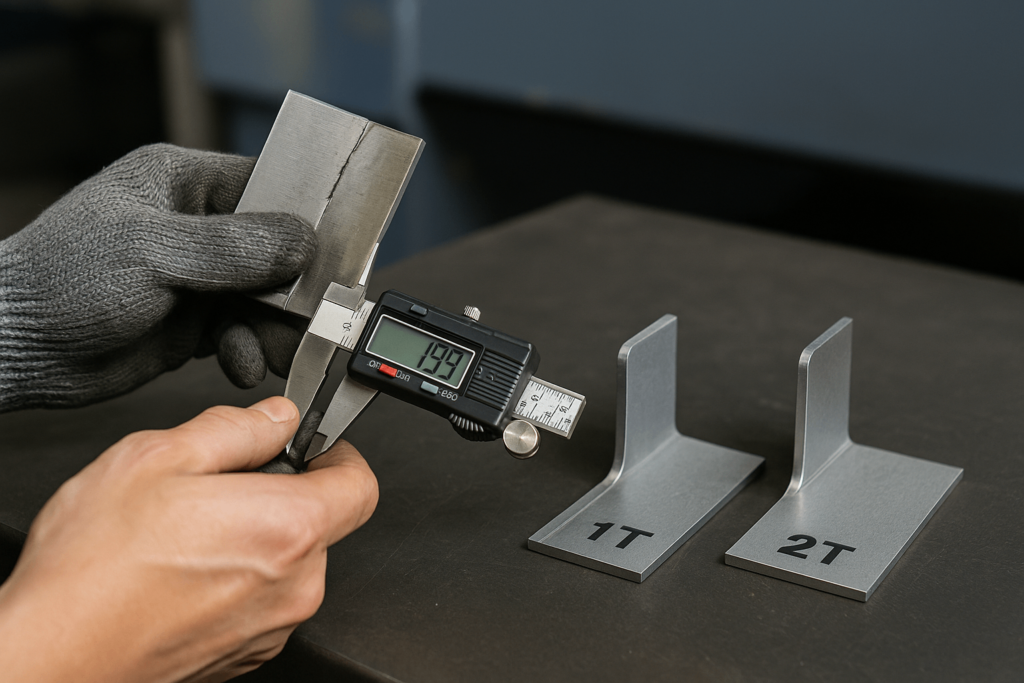
Strategic Feature Placement: The "Keep-Out Zone" for Holes and Fasteners
The immense pressure from a press brake during bending causes material near the bend line to stretch and deform. Placing features like holes and cutouts within this deformation zone can compromise the entire assembly. A round hole will be pulled into an oval, leading to critical alignment issues with internal PCBs or connectors.
To avoid this issue, a “keep-out zone” must be respected. Therefore, proper spacing of features is critical during early design reviews. A robust formula is to ensure the edge of any feature is at least 2.5 to 4 times the material thickness plus the bend radius away from the bend line.
A case study of an electronics chassis highlights this risk: a USB port cutout placed just 4mm from a bend line consistently shifted position during forming, preventing alignment with the circuit board. This forced an expensive manual rework of the entire batch—a delay and cost that proper DFM review would have avoided.
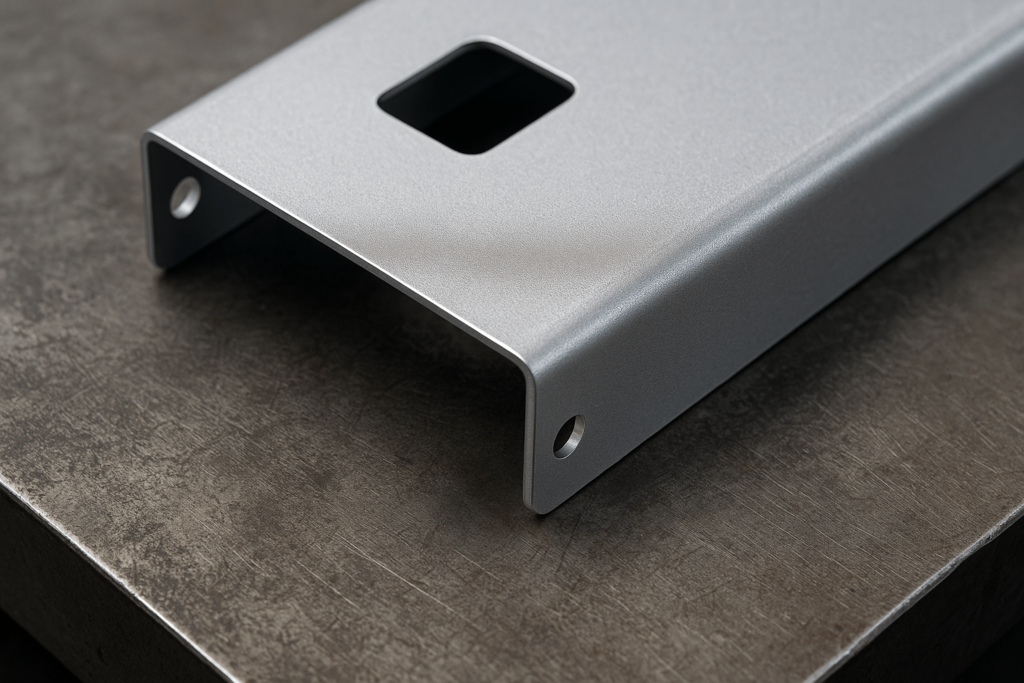
"Adding Muscle" to Your Design: Hems, Curls, and Flanges
Advanced features can increase structural rigidity without adding material thickness or weight—a key consideration for managing both material and shipping costs for bulk orders from OEM sheet metal parts suppliers.
Flanges: To ensure a stable and accurate bend, the flange height must be at least 4 times the material thickness.
Curls: These rolled edges eliminate sharp corners and add strength. The outer radius should be at least twice the material thickness.
Hems: These folded edges reinforce the part. The return length should be at least 4 times the material thickness.
Material Selection: Choosing the Right Armor for Your Application's Environment
Material selection is a critical business decision that balances mechanical properties, corrosion resistance, weight, and unit cost. An incorrect choice can lead to premature field failures and costly warranty claims, while over-engineering needlessly inflates costs across a large production run.
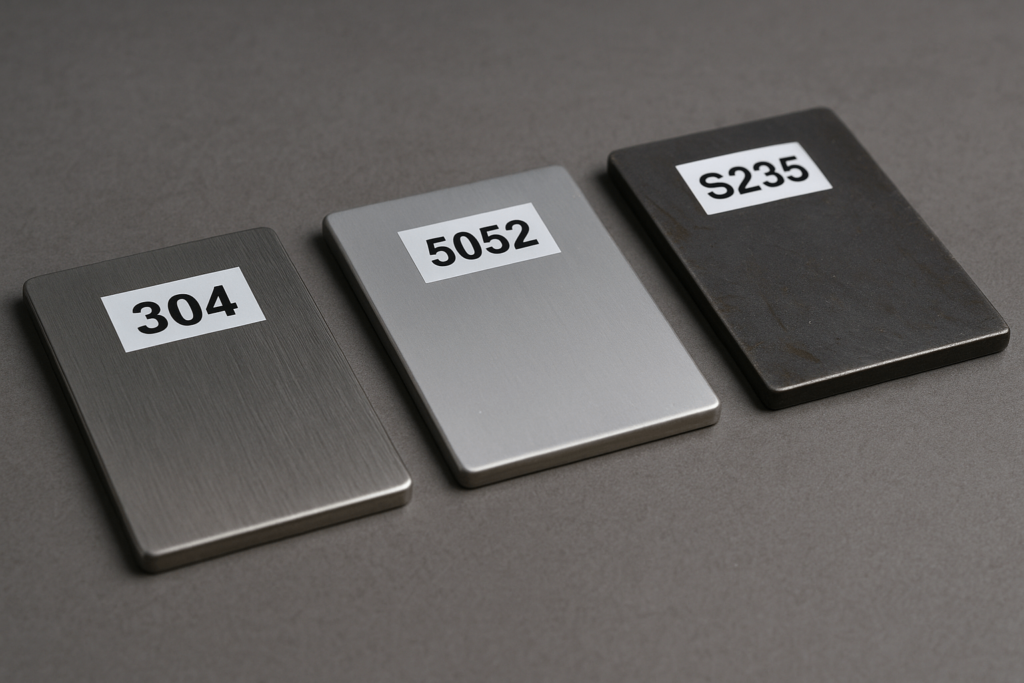
The Industrial Workhorses: Stainless Steel (304 vs. 316L)
Stainless steel is prized for its strength and corrosion resistance, making it a default choice for applications where reliability is paramount.
304 Stainless Steel (1.4301): The industry standard, offering excellent general corrosion resistance and good weldability. It is the ideal choice for industrial machinery and food processing equipment.
316L Stainless Steel (1.4404): Known as “marine grade,” 316L contains molybdenum, dramatically enhancing its resistance to chlorides (like salt water) and acids. Specifying this material is a crucial risk-management decision for any application involving marine or chemical environments.
The Lightweight Champion: Aluminum Alloys (5052 vs. 6061)
Aluminum offers an outstanding strength-to-weight ratio, perfect for applications where weight impacts portability and shipping costs.
5052 Aluminum (3.3523): This alloy provides an excellent balance of good formability and superior corrosion resistance, especially in marine environments.
6061 Aluminum (3.3211): A higher-strength structural alloy used for load-bearing applications. However, this added strength comes with a DFM trade-off: 6061 requires a significantly larger bend radius (see 1T rule) to avoid cracking.
The Cost-Effective Choice: Carbon Steel (S235 vs. S355)
For controlled environments where a protective finish is applied, carbon steel offers excellent strength at a lower material cost, a key factor for volume procurement.
S235 Steel (1.0038): A soft, pliable steel ideal for internal frames and brackets where high formability is required.
S355 Steel (1.0570): A high-strength structural steel used for heavy-duty applications like machinery bases where load-bearing capacity is the primary concern.
From 2D to 3D: A Look Inside the Precision Fabrication Process
Understanding the core manufacturing processes is essential for a procurement manager sourcing bulk custom sheet metal parts. Your design choices dictate which technologies are used, which in turn affects precision, unit cost, and lead time. A knowledgeable buyer can ensure the most efficient process is used for their specific order volume.
The First Cut: Laser Cutting vs. Turret Punching
The initial step is cutting the flat pattern. The two dominant technologies are laser cutting and turret punching, each with advantages for different production scales.
Laser Cutting: Uses a high-powered laser for exceptionally precise cuts. Its flexibility makes it the champion for prototypes, low-volume runs, and complex geometries.
Turret Punching: A mechanical process that stamps out shapes. Its strength is speed and efficiency. For high-volume runs with standard features, it is significantly faster and more cost-effective.
The choice is strategic: laser cutting offers precision for custom work, while turret punching provides economy for scale.
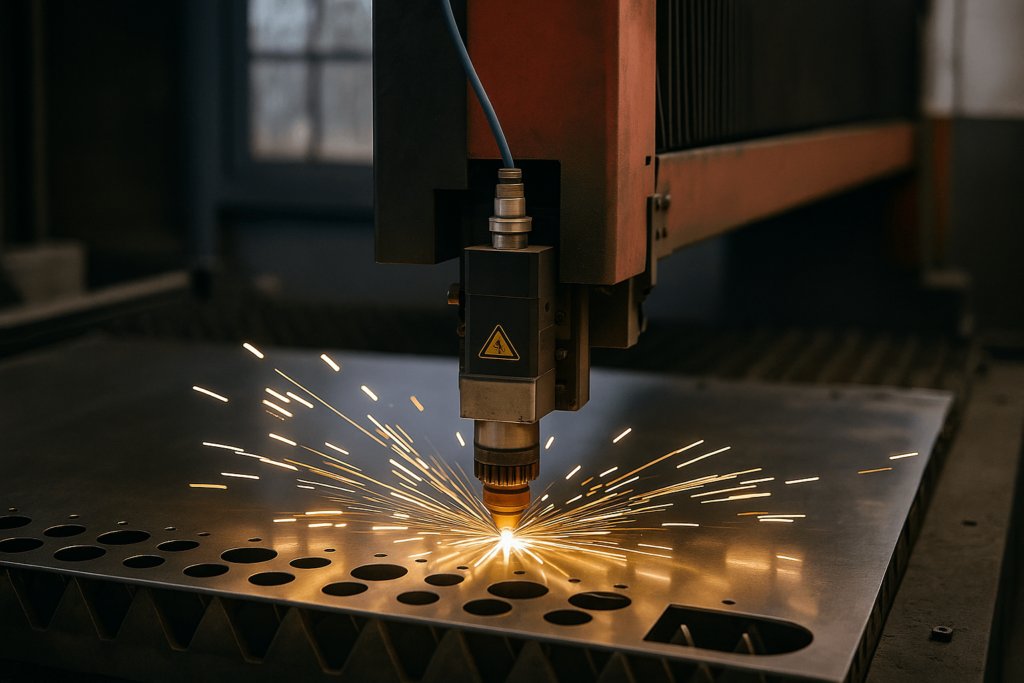
Joining it All Together: Welding vs. Self-Clinching Fasteners
This decision has significant implications for cost, durability, and maintenance.
Welding (Permanent Joints):
TIG Welding: A precise, clean process producing strong, aesthetically pleasing welds. It is the preferred method for thin materials and highly cosmetic applications.
MIG Welding: Much faster and more cost-effective, making it the workhorse of industrial production.
Self-Clinching Fasteners (Serviceable Joints):
Often called PEM® fasteners, these are pressed into the metal, creating strong threads without heat. This method is a game-changer for enclosures requiring service access. Key advantages include no heat distortion and a 20-40% cost savings over welding.
A direct comparison of a 10x10x6 inch enclosure showed the fastened version costing ~$375, while the fully welded version was ~$550—a nearly 50% increase, a critical data point for any procurement manager.
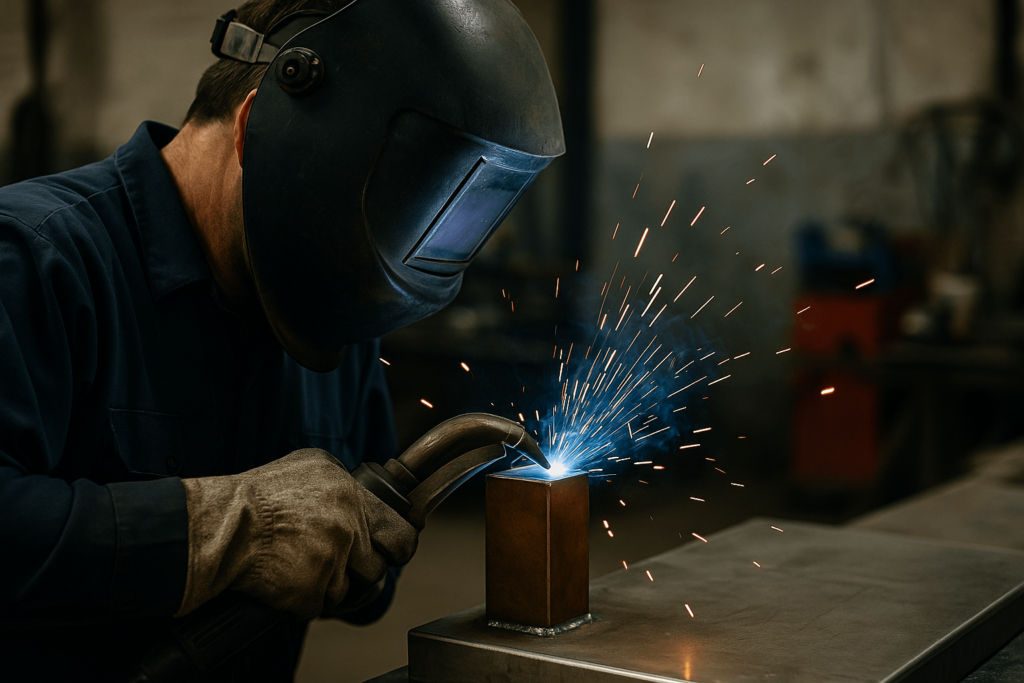
Advanced Engineering: Solving the Enclosure Trilemma – Sealing, Shielding & Cooling
A modern enclosure must actively protect its contents. This creates the “Enclosure Trilemma,” a battle to balance three competing requirements—sealing (IP Rating), shielding (EMI/RFI), and cooling (Thermal Management)—especially in industrial sheet metal enclosure designs for electronics and automation. Mastering enclosure design means mastering this trilemma.
Challenge 1: Keeping Dust & Water Out – A Guide to IP Ratings
Ingress Protection (IP) ratings, defined by the international standard EN 60529, are a critical compliance point for products sold in international markets.
IP65: Dust-tight and protected against low-pressure water jets. Suitable for general outdoor use and wash-down environments.
IP67: Dust-tight and protected against temporary immersion in water up to 1 meter for 30 minutes.
Achieving a high IP rating requires meticulous design.Continuous seam welds are superior for creating a waterproof barrier. The design of the gasket and its compression is critical. Finally, all cable glands and connectors must carry an equivalent IP rating to maintain system integrity.
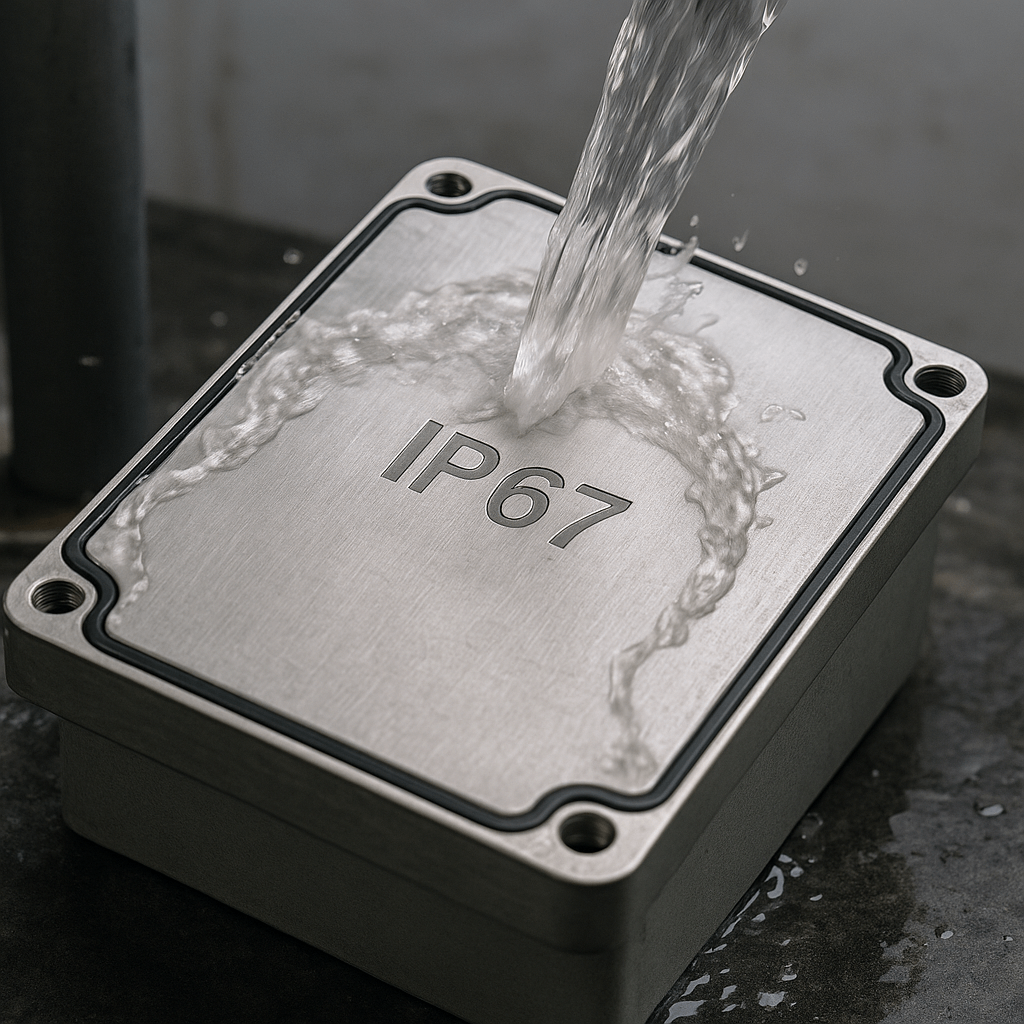
Challenge 2: Taming the Noise – EMI/RFI Shielding Best Practices
Electromagnetic Interference (EMI) can cause malfunction and non-compliance with regulatory standards. A metal enclosure acts as a Faraday Cage, an unbroken conductive barrier. The most important principle is electrical continuity. Any gap or seam acts like an antenna.
Common failure points are seams, doors, and vents. To maintain shielding, conductive gaskets must be used at all panel interfaces. Ventilation openings must be covered with shielded vents or honeycomb filters. A proper low-impedance ground connection is also essential.
Challenge 3: Beating the Heat – A Guide to Thermal Management
Excessive heat is the number one killer of electronics, reducing reliability by 50% for every 10°C rise above the optimal range.
Step 1: Calculate Your Total Heat Load. This is the sum of the internal heat load (watts from components) and external heat transfer (from the ambient environment).
Step 2: Choose Your Cooling Strategy. This depends on the heat load and operating environment.
Passive Cooling (Natural Convection): For low heat loads where ambient temperature is cooler than desired internal temperature.
Forced Air Cooling (Fans): The most common active method. It is effective and low-cost but requires a clean environment and breaks the enclosure’s seal.
Closed-Loop Cooling (A/C, Heat Exchangers): Required for harsh environments or when the internal temperature must be below ambient. These systems maintain a high IP rating.
As a result, your choice of cooling method directly impacts the IP and EMI ratings you can achieve.
The Final Touch: Surface Finishes for Durability and Brand Perception
The surface finish is the first thing a user sees, directly reflecting on your brand’s quality. It provides long-term durability and corrosion resistance.
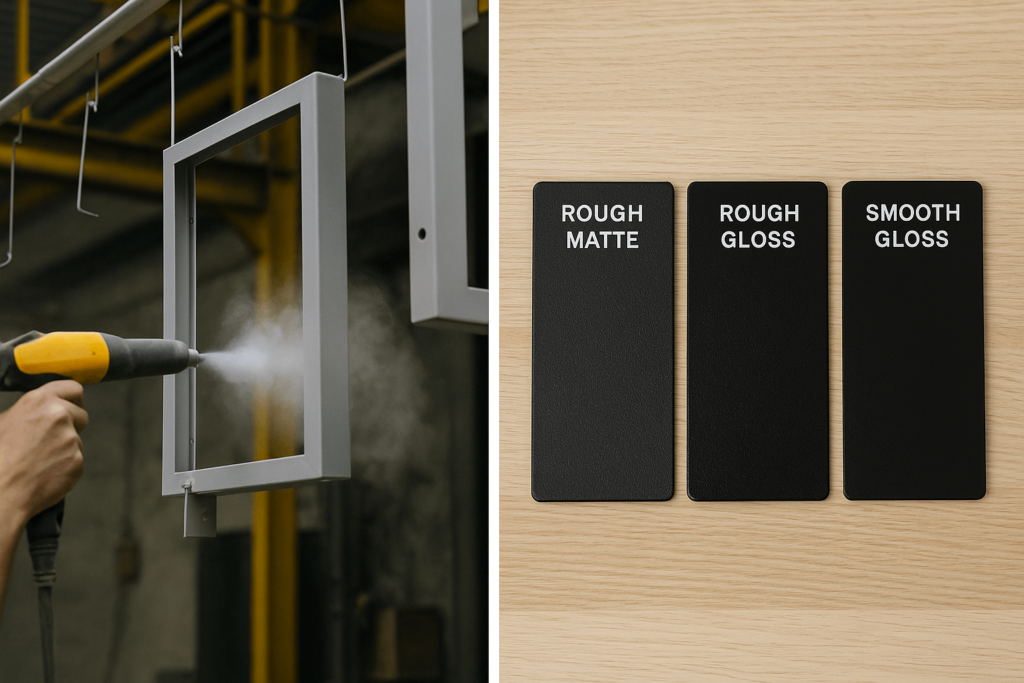
Protective Coatings: Powder Coating vs. Anodizing vs. Plating
These processes provide a robust protective layer, ensuring longevity in the field.
Powder Coating: A hard, durable finish that is more resilient than conventional paint. It is the versatile standard for steel and aluminum.
Anodizing (Aluminum Only): An electrochemical process creating a very hard, wear-resistant surface. It is an excellent choice for high-wear applications.
Plating (Zinc): Primarily for carbon steel, zinc plating provides a sacrificial coating for excellent, cost-effective corrosion protection.
Applying Your Brand: Silkscreening vs. Digital Printing
Applying graphics and logos is essential for branding. The choice of method impacts durability, cost at volume, and visual quality.
Silkscreening: Uses a stencil to apply durable epoxy ink. For simple, single-color graphics in high volumes, silkscreening is highly cost-effective.
Digital Printing: An industrial inkjet process. It is ideal for complex, multi-color graphics and low-volume prototype runs.
A critical detail often overlooked: a heavily textured powder coat can degrade the sharpness of graphics. For clear text, a minimum font size of 11 points is often required on such surfaces.
Conclusion: Your Pre-Production Audit for a Flawless, Scalable Enclosure
Designing a custom sheet metal cover is a series of strategic business decisions that directly influence cost, quality, and time-to-market. A successful design is not only functional but also inherently manufacturable, reliable, and cost-effective at scale.
Before committing a design to high-volume production or coordinating with a contract metal fabrication service provider, a final pre-production audit is essential. This checklist serves as a final checkpoint:
DFM Compliance: Have all bend radii been verified? Are all holes outside the critical “keep-out zone” to prevent batch-level deformation?
Material & Environment Match: Does the selected metal align with the product’s service environment to minimize future warranty costs?
Cost-Optimized Joining Strategy: Have you weighed the cost-savings and serviceability of fasteners against the permanence of welding?
Functional System Integrity: Is the thermal strategy sufficient for the heat load and compatible with IP and EMI requirements to ensure reliability and regulatory compliance?
Finish & Brand Durability: Does the specified finish ensure your brand’s quality is represented for the life of the product?
Ultimately, the most valuable action is to engage with your manufacturing partner early. Collaborating with a seasoned fabricator ensures that potential design and production challenges are identified well before full-scale manufacturing begins.
If you are looking for a reliable partner for your next custom sheet metal cover project, we are here to help.

